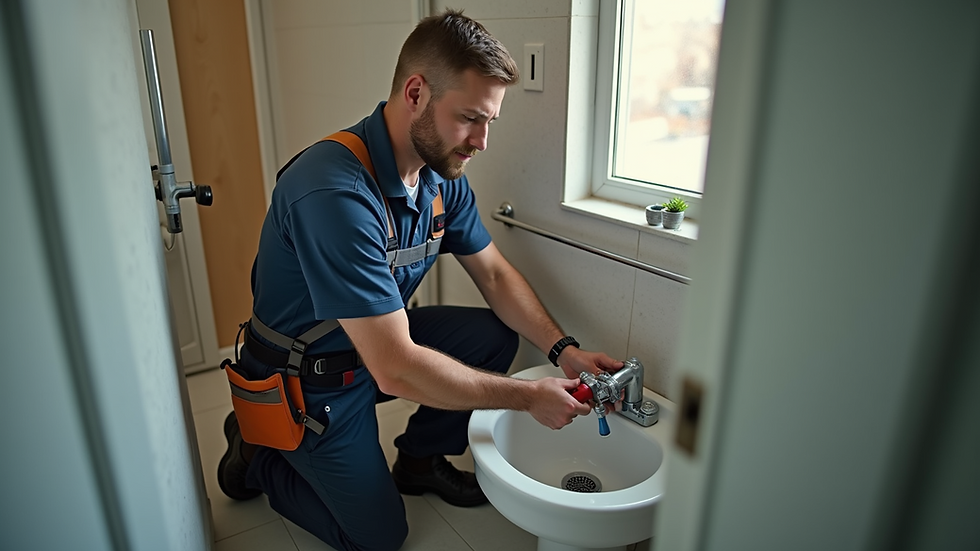Crafting Effective Website Designs for Plumbing Businesses
- Donald W. Carroll
- Jul 20
- 3 min read
Creating a website for a plumbing business can be a daunting task. But with the right approach, you can develop an attractive and functional site that not only showcases your services but also attracts new customers. In this article, we will explore how to design plumbing websites that are not just visually appealing but also user-friendly and optimized for conversions.
Plumbing Websites Design
When designing a plumbing website, it’s essential to consider the target audience and their needs. A well-designed site can help communicate what your business offers while also building trust with potential customers. Here are some key elements to include:
Simple Navigation: The design should be straightforward, allowing users to find essential services quickly. Use clear headers and a well-structured menu to improve usability.
Mobile Responsiveness: Many users search for services on their smartphones. Ensure your website is mobile-friendly to accommodate these visitors.
Clear Calls to Action (CTAs): The goal is to convert visitors into customers, so include prominent CTAs throughout the site. Encourage users to contact you or schedule services with easy-to-find buttons.

Essential Features of Plumbing Websites
To maximize the effectiveness of your plumbing website, certain features are necessary:
Service Pages: Create dedicated pages for each service you offer. Use high-quality images, thorough descriptions, and customer testimonials. These pages should inform users and help with SEO.
Contact Information: Make sure your contact details are easy to find. Include a phone number, email address, and a contact form. Consider implementing a live chat feature for immediate interaction.
About Us Page: Establish credibility by including an "About Us" section that tells the story of your plumbing business, including your experience and expertise.
Blog Section: Offer valuable content through a blog. Articles can provide tips on plumbing issues, showcase completed projects, or detail seasonal maintenance tasks. This can also boost your SEO efforts.
Customer Reviews and Testimonials: Displaying positive reviews builds trust. Consider integrating a review platform or displaying testimonials prominently on your homepage.

What is the Best Social Media for Plumbers?
Utilizing social media can be a game-changer for plumbing businesses. It allows you to reach a broader audience and connect with potential customers. Here are the best platforms for plumbers:
Facebook: This platform is effective for sharing updates about your services, customer testimonials, and engaging in local community groups. You can also run targeted ads to reach people in your service area.
Instagram: Ideal for showcasing your work visually. Post before-and-after photos of plumbing projects, tips, and even short videos demonstrating common plumbing solutions.
YouTube: As a plumber, you can create informative videos that highlight plumbing tips, DIY projects, or explanations of plumbing issues. This can position you as an authority in your field.
LinkedIn: This platform is often overlooked but can be beneficial for networking with other professionals and generating commercial leads.

SEO Strategies for Plumbing Websites
To make your plumbing website stand out, you need to implement SEO strategies. Here are effective tactics to consider:
Keyword Research: Identify keywords related to your services that potential customers are searching for. Utilize tools like Google Keyword Planner to find opportunities.
On-Page SEO: Optimize each page's title, meta description, headers, and content with relevant keywords. Ensure that images have alt text for additional SEO benefits.
Local SEO: Since plumbing services are often locally based, focus on local SEO. Claim your Google My Business listing, and encourage satisfied customers to leave reviews.
Content Marketing: Regularly write blog posts that address common plumbing questions or seasonal tips. This not only helps with SEO but also positions you as an expert.
Backlinks: Seek opportunities to gain backlinks from reputable sites within the home and service industry. This increases your site's authority.
Incorporating these strategies into your web design will help enhance visibility and attract more visitors. A website that ranks well on search engines is more likely to convert visitors into paying customers.
Final Thoughts
Effective website design for plumbing businesses is not just about aesthetics; it involves thoughtful planning, user experience consideration, and strong SEO practices. Ensure your site is easy to navigate, showcases your services clearly, and provides valuable content for your audience.
Furthermore, consider the integration of social media to enhance your reach and engagement with potential customers. Plumbing businesses that adapt to modern web standards and practices are more likely to succeed in an increasingly digital marketplace.
For even more information on web design and other digital strategies, consider exploring web design for plumbers. This valuable resource can guide you in creating a compelling online presence for your plumbing business.
By following these guidelines, your plumbing website can become an effective tool for growth, helping you attract new clients and retain existing ones. Take your time to build a site that reflects your brand and serves your audience’s needs.




Comments